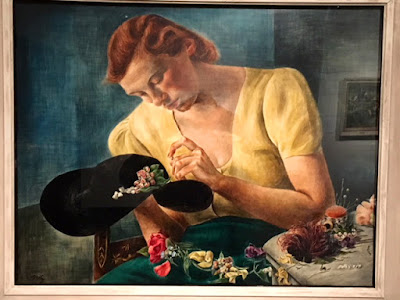Swope Art Museum Part II
Zoltan Sepeshy, Wild Flowers, tempera, c. 1940. I love the
way Sepeshy splashed bright yellow light on the woman's
shoulders to contrast the enormous black hat she works on.
His model is so substantial, almost like a sculpture.
Most artists, including me, need a great deal of distraction-free time so they can sort of fall into their own imagination to see where it will carry them. To be any good at all an artist has to embrace solitude as a friend.
We all need to feel we're part of something bigger. My circle includes artists from the past. Particularly helpful to me are American realist painters from the 1930's and '40's, an area where
the Swope Museum of Art more than excels.
Jack Levine, A Joy Forever, oil, 1953. Levine combined sharp
social criticism with a unique style of a flickering broken
brushwork. Seen in person, the painting's surface becomes
the star of the show. I'm sad my photo only begins to capture
the feeling of Levine's paint handling.
Last week I traveled to Terre Haute, Indiana to judge the Swope Art Museum's annual juried regional exhibition. The Museum recently re-hung an expanded exhibit of works from their permanent collection. When I wasn't jurying I had a ball checking out that new display. There are too many to mention, but here are a few of my favorites.
William Bailey, The Stage, oil, 1965. An enormous
painting, Bailey sits at the opposite end of the spectrum from
the Jack Levine oil above.
the Jack Levine oil above.
In works like these artists who went down the path before me left us some of the most thoughtful and sensitive records of how the world looked and felt to them.
John Rogers Cox was the first Director of the Swope and was
responsible for many of the impressive early acquisitions to
its collection. Cox was a powerful painter in his own right
as seen in his White Cloud, oil, 1943-46.
It is not that our job as artists now is to just repeat the techniques of these earlier artists. But we can catch some of the shimmering energy that lies in their paintings. In our hands it will lead to different results. But we can add our contribution to what I like to think of as "the long chain" of art that stretches back centuries.
John White Alexander, Phyllis, oil, 1909. This
painting achieves a soft, glistening light that I
love. Alexander created a wonderfully asymmetrical
silhouette to make the model's entire figure contribute
to expressing personality.
And here I am grinning away next to Grant Wood's final
painting, Spring in Town, that is just returned from
New York where it was one of the stars of the Whitney
Museum of American Art's major Grant Wood
exhibition. In person this painting is a hoot, with
all sorts of unexpected goings on in the background.
New York where it was one of the stars of the Whitney
Museum of American Art's major Grant Wood
exhibition. In person this painting is a hoot, with
all sorts of unexpected goings on in the background.








